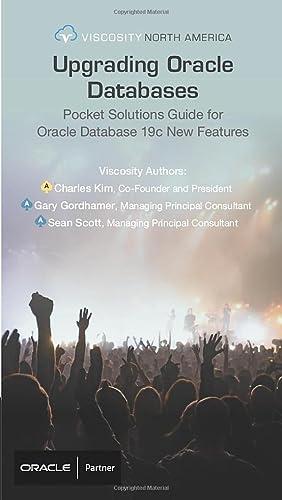Question
QUESTION 1 In this table: cust_id fname lname birth_date email 1 James Hadley 1972-04-22 james@example.com, james@nowhere.com 2 Susan Tingley 1968-08-15 susan@example.com 3 Frank Tucker 1958-02-06
QUESTION 1
-
In this table:
cust_id fname lname birth_date email 1 James Hadley 1972-04-22 james@example.com, james@nowhere.com
2 Susan
Tingley
1968-08-15 susan@example.com 3 Frank Tucker 1958-02-06 NULL 4 John Hayward 1966-2-22 susan@example.com Which cust_id(s) is/are the main reason the table does NOT meet First Normal Form (1NF)?
a 3
b 1 and 3
c 1
d 2 and 4
5 points
QUESTION 2
-
Consider this table which violates 3NF
customer-branch
cust_id fname lname branch branch_zip_code 1 James Hadley Chicago 60007
2 Susan
Tingley
Naperville 60540 3 Frank Tucker Elmhurst 60106 4 John Hayward Chicago 60007 Which statement best illustrates the insertion anomaly that can arise due to the 3NF violation?
a INSERT INTO customers (cust_id, fname, lname, branch, branch_zip_code) VALUES (5, 'Louis', 'Blake", 'Chicago NW', 60007);
b INSERT INTO customers (cust_id, fname, lname, branch, branch_zip_code) VALUES (5, 'John', 'Hayward', 'Chicago', 60007);
c INSERT INTO customers (cust_id, fname, lname, branch, branch_zip_code) VALUES (5, 'Louis', 'Blake', 'Naperville', 60500);
d INSERT INTO customers (cust_id, fname, lname, branch, branch_zip_code) VALUES (4, 'Louis', 'Blake', 'Wheaton', 60187);
5 points
QUESTION 3
-
Consider this table which tracks employees (by id and name) and the number of hours they worked on each project (project number and name). The primary key is {Eid,Pnumber} (Employee ID+Project Number)
Employee_Project +------+-------+---------+---------+----------+ | Eid | Pnumber | Hours | Ename | Pname |
+---------+------+-------+---------+----------+ | 1 | 100 | 15 | Hadley | Google | | 2 | 102 | 30 | Tingley | Facebook | | 3 | 27 | 5 | Tucker | Amazon | | 4 | 100 | 20 | Hayward | Google |
| 2 | 100 | 30 | Tingley | Google |
+------+---------+-------+---------+----------+ Which columns are responsible for the table failing to meet 2NF? (Select all that apply)
a Hours
b Eid (Employee ID)
c Pname (Project Name)
d Pnumber (Project Number)
e Ename (Employee Name)
5 points
QUESTION 4
-
Consider this table which satisfies Fourth Normal Form (4NF)
student_id course student_hobby 1 Math Running 1 Science Running 1 Math Chess 1 Science Chess 2 Math Baseball 2 Math Chess 2 Math Movies If student 2 starts taking Biology, how many rows will need to be added to the table?
a 2
b 4
c 3
d 1
5 points
QUESTION 5
-
Using the "bank" database that we've been using in the class, which query will produce the most rows of output?
A) SELECT open_branch_id FROM account;
B) SELECT DISTINCT open_branch_id FROM account;
C) SELECT DISTINCT open_branch_id, cust_id, open_date, close_date FROM account;
D) SELECT open_branch_id FROM account LIMIT 20;
a C
b A
c D
d B
5 points
QUESTION 6
-
Using the "bank" database that we've been using in the class, which query will produce the fewest rows of output?
A) SELECT open_branch_id FROM account;
B) SELECT DISTINCT open_branch_id FROM account;
C) SELECT DISTINCT open_branch_id, cust_id, open_date, close_date FROM account;
D) SELECT open_branch_id FROM account LIMIT 2;
a A
b B
c C
d D
5 points
QUESTION 7
-
If you join a table to itself, what kind of join are you using?
a Selective Join
b Cross Join
c Self Join
d You can't join a table with itself
5 points
QUESTION 8
-
Which SQL keyword is used to retrieve only unique values?
a UNIQUE
b DIFFERENT
c DISTINCTIVE
d DISTINCT
5 points
QUESTION 9
-
Which of the following SQL statements against the bank database is correct?
a SELECT * FROM account WHERE open_date BETWEEN( '2003-07-30' , '2004-06-30');
b SELECT open_branch_id FROM account WHERE open_date '2003-07-30' BETWEEN '2004-06-30';
c SELECT FROM account WHERE open_date BETWEEN '2003-07-30' AND '2004-06-30';
d SELECT * FROM account WHERE open_date BETWEEN '2003-07-30' AND '2004-06-30';
5 points
QUESTION 10
-
Using our bank database, which are legal MySQL queries? (Do not generate an error)
A) SELECT emp_id*lname FROM employee;
B) SELECT emp_id*superior_emp_id from employee;
PLEASE EXPLAIN THANKS!a Neither A nor B
b Both A and B
c B only, because both columns are numeric types
d A only because emp_id is a numeric type
Step by Step Solution
There are 3 Steps involved in it
Step: 1

Get Instant Access to Expert-Tailored Solutions
See step-by-step solutions with expert insights and AI powered tools for academic success
Step: 2

Step: 3

Ace Your Homework with AI
Get the answers you need in no time with our AI-driven, step-by-step assistance
Get Started


